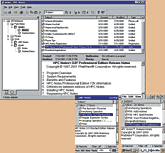These apps help bring handhelds into the fold


Connecting state and local government leaders
Handheld computers are serious data and communications tools in agencies as diverse as the Forest Service and the Navy. The next step for them is to be taken seriously as part of the enterprise.

PhatWare Corp.'s HPC Notes 3.07 synchronizes notes from Palm devices, right, or Pocket PCs running Windows CE 2.0 or later, far right, with Windows desktop PC systems, top. It's priced at $30 per user.
The list of products within each of the above categories is not inclusive, and there is often some degree of cross-functionality between the applications listed'such as middleware programs with strong synchronization features.
Synchronization software. Most synchronization software resides on servers and lets mobile handheld users work with data stored on a network. When the data is changed on the handheld or on the server, the software makes changes in the data on the server or handheld, or both.
The store-and-forward architecture of the most advanced synchronization applications lets some of data be stored on the mobile devices, enabling data to be entered while offline, and synchronized with the server when connections are renewed. Connection times and related expenses are thus minimized.
The best synchronization software supports multiple handheld devices, OSes and databases, as well as multiple data types used by different databases. Security features help discourage intruders from changing data.
Synchrologic Inc.'s iMobile Data Synchronization 4.1 platform is a server-based store-and-forward platform that synchronizes data between most enterprise databases and handhelds, either online or offline. Extended Systems Inc.'s XTNDConnect Server Professional Edition 2.6.1 was developed on a similar architecture and contains a scheduling add-on for Pocket PCs.
The version of Microsoft's ActiveSync 3.5 that comes bundled with Pocket PC 2002 devices is client-based software used to synchronize Microsoft Outlook data between Pocket PCs and desktops. But a server version of ActiveSync is bundled with the new Microsoft Mobile Information Server 2002, which falls under the category of middleware.
Middleware. This is, by definition, an ambiguous category. In this case, it is core software that brings wireless functionality to both mobile and enterprise platforms, but many middleware products also include related synchronization and development features.
For example, Vaultus Inc.'s customizable VMP 2.0 platform provides a mobile development framework for user authentication, data synchronization, network optimization and security. Brience Inc.'s Brience 3.0 is a complete suite of middleware.
Messaging. Messaging software for handhelds generally isn't as advanced or complex as synchronization or middleware apps, but it doesn't have to be.
Messaging software can consist of fully developed client-server or less sophisticated client applications that help users of handheld devices communicate with enterprise servers or desktops to upload and download e-mail, files, voice messages and faxes.
Some work with dial-up modems attached to the handheld; others work via wireless fidelity or even Bluetooth connections. Still others are designed to handle serial/parallel port or Universal Serial Bus connections in wired environments. Unlike synchronization software, most handheld messaging works in real time'that is, the handhelds must be directly connected to the information source at the other end.
Copies of most of the messaging programs listed here and many others'including some excellent contact managers, spreadsheets, databases and word processors'can be downloaded at reasonable prices from many online software outlets.
J.B. Miles of Pahoa, Hawaii, writes about communications and computers. E-mail him at jbmiles@gte.net.
NEXT STORY: Spectrum Summit seeks peace in the air




